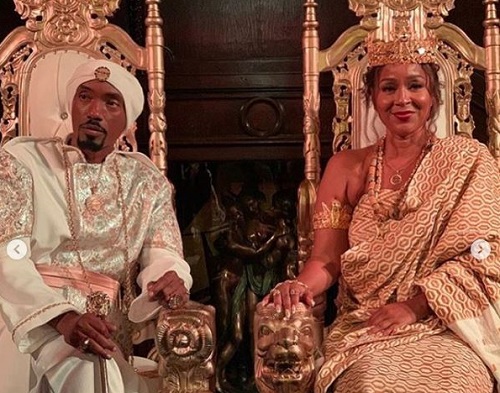
The Uncomfortable History Behind the Idiom ‘We Was Kings’
Every so often a Diaspora Wars will erupt on social media. It’s never quite clear what factors incite the digital skirmishes at the time, but one proclamation always rears its head: certain African Americans/Blacks want everyone to know that they are the descendants of royalty. They are not wrong.
Though I was in Ghana for the Year of Return, I was not in the country for the height of the celebrations in December, marked by one extravagant party after the next. My visit in September – October coincided with no planned parades or mega events, which made access to Ghana’s historical sites easier and conversations with local experts less harried. Because I was researching life in 18th century Gold Coast, slavery – and its consequences – ended up becoming a large topic of conversation. Just as access to and dissemination of personal data is today’s most valuable (and controversial) form of currency, so was at the time access to and distribution of Black flesh…and almost everyone had a hand in the trade.
It is now widely accepted that African nobility and royalty played a major role in propagating the trans-Atlantic slave trade; sometimes as unwitting pawns in the Europeans’ subjugating schemes, and sometimes as calculating capitalists themselves. The King of Dahomey is notorious for having enriched himself through the trade of African lives in return for Western commodities. Benin hosted what was once West Africa’s biggest slave port, the departure point for more than a million people in chains. And when the British declared all slave trading illegal in 1807, the king of Bonny expressed his dismay saying:
We think this trade must go on. That is the verdict of our oracle and the priests. They say that your country, however great, can never stop a trade ordained by God himself.
We see how the common man – the poor, oppressed and conquered – fell subject to a life of bondage; but what is less talked about is how members of elite society fell victim to an enterprise that was supposed to cement their privilege.
There is a common mythos surrounding the proliferation of slave trade; that greedy and murderous whites singlehandedly and recklessly attacked unsuspecting villages, selected the most viable humans from the living that remained after the carnage and then reduced communities to ash. This was rarely the case, as the frequency of such campaigns would’ve presented far too much risk to European lives, and as the Asante will attest, gives more credit to their military prowess than they deserve. Like the diversity of the people that were caught in slavery’s snares, so were the tactics employed to ensure their capture.
One of those tactics, according the local historians I spoke to, was debt – method that African regents and rulers frequently found themselves victim to.
In circumstances of barter, European traders would sometimes offer deferment of payment as a demonstration of ‘goodwill’ to local chiefs who tightly controlled all trade with the foreigners. These chides in return would mortgage their lives as surety, indicating their moral uprightness and virtue. After all, who wouldn’t have faith in the integrity of a man who was willing to risk his freedom for gunpowder and mirrors? And yet, that’s exactly what would happen. A failed harvest – or failed planning – would result in an African ruler’s inability to repay the debt he’d agreed to the season prior. His honor would demand that he submit himself to bondage. These traditional rulers would often be kept as “fort slaves”, men and women who did jobs at the fort master’s pleasure – or worse, would end up on the gangplank and into the belly of floating tombs bound for the Americas. Sometimes, they would offer up their own children (or other members of their household of great value) to serve out the terms of their debt instead. Whatever the decision made, the consequence was African royalty finding their way into an unexpected life of perpetual service fields and chambers of their white captors.
There are of course, instances of African nobility enslaved under the circumstances that frequently capture the imagination. Prince Abd-al Rahman Ibrahima, the details of whose life and capture have been immortalized in the book Prince among Slaves: The True Story of an African Prince Sold into Slavery in the American South is one such example.

Image source: Library of Congress
“Around 1788, at the age of approximately 26, Ibrahima was taken captive after a raid against a rival tribe, the “Hebohs.” Ibrahima’s captors sold him into slavery, and after surviving the Middle Passage, he was auctioned to Colonel Thomas Foster, on whose Natchez, Mississippi, cotton plantation he became a field hand.” (source: https://docsouth.unc.edu/highlights/ibrahima.html)
The prince eventually secured his freedom and was re-emigrated to Africa, thanks largely to the efforts of President John Quincy Adams, but he never saw his beloved Futa Jallon again. Survived by his wife and children (only two of which whom were freed with him) he died in Liberia. His other children remained in captivity in Mississippi after his supporters’ unsuccessful attempts to raise enough capital to free them.
It’s true: there is an unhealthy obsession with factions of the Diaspora and their presumed genetic proximity to African royalty and/or their pursuit of that particular acclaim. The most recent (and abhorrent) example that comes to mind is LisaRaye’s erroneous announcement to the world that she had been crowned ‘Queen Mother of Ghana’…a title that does not and never will exist. As cringe-y and eye-roll inducing as these moments and declarations may be, we who have knowledge have a duty to open the lines of communication for important discussions about the complex realities about what it means to be a descendant of African kings and queens.




